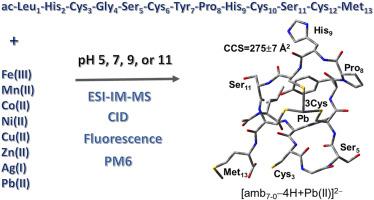International Journal of Mass Spectrometry ( IF 1.6 ) Pub Date : 2021-06-01 , DOI: 10.1016/j.ijms.2021.116640 Rajpal Vangala , Laurence A. Angel

|
Three analog methanobactin (amb7) peptides containing the primary structure acetyl-Leu1-His2-Cys3-Gly4-Ser5-Cys6-Tyr7-Pro8-His9-Cys10-Ser11-Cys12-Met13 but differing by the number of disulfide bridges, have been studied for their reactivity with Fe(III), Mn(II), Co(II), Ni(II), Cu(II), Zn(II), Ag(I), and Pb(II) using electrospray ionization-ion mobility-mass spectrometry (ESI-IM-MS) and fluorescence quenching. The Pb(II) bound only with the amb7-0 (0 disulfide bonds), Zn(II) only to amb7-0 and amb7-1 (1 disulfide bond), Ni(II) only to amb7-1 and amb7-2 (2 disulfide bonds), and Cu(II) to amb7-2, concomitant with the oxidation of amb7-0 and amb7-1. The reduction of Cu(II) to Cu(I) resulted with 1-4Cu(I) binding to amb7-1 and amb7-0, while Ag(I) also exhibited 1-6 Ag(I) ions binding through a mechanism indicative of labile proton exchange. The binding of the oxidized Co(III/V) and Mn(III/V) were observed at pH 9 and 11, while Fe(III) did not exhibit significant binding. The observed negatively charged complexes were consistent with the deprotonation of the metal sites of Cys, His, carboxyl terminus and indicative of ion-ion interactions with the metal at pH 7, 9, and 11. The positively charged complexes were indicative of ion-dipole metal binding but at pH 9 and pH 11 gave results similar to those of the negative ion analyses. Fluorescence quenching also qualitatively agreed with the ESI-IM-MS results providing evidence that they revealed the solution-phase metal binding behavior of amb7.
中文翻译:

ESI-IM-MS 揭示了三种具有不同游离半胱氨酸数的模拟甲烷杆菌肽在生理 pH 值下的金属结合
三个类似物甲烷杆菌素 (amb 7 ) 肽包含一级结构乙酰-Leu 1 -His 2 -Cys 3 -Gly 4 -Ser 5 -Cys 6 -Tyr 7 -Pro 8 -His 9 -Cys 10 -Ser 11 -Cys 12 - Met 13但由于二硫键的数量不同,已经研究了它们与 Fe(III)、Mn(II)、Co(II)、Ni(II)、Cu(II)、Zn(II)、Ag( I) 和 Pb(II) 使用电喷雾电离-离子迁移率-质谱法 (ESI-IM-MS) 和荧光猝灭。Pb(II) 仅与 amb 结合7-0(0 个二硫键)、Zn(II) 仅与 amb 7-0和 amb 7-1(1 个二硫键)、Ni(II) 仅与 amb 7-1和 amb 7-2(2 个二硫键)和 Cu (II) 转化为 amb 7-2,伴随 amb 7-0和 amb 7-1的氧化。Cu(II) 还原为 Cu(I) 导致 1-4Cu(I) 与 amb 7-1和 amb 7-0 结合,而 Ag(I) 还通过指示不稳定的质子交换的机制表现出 1-6 个 Ag(I) 离子结合。在 pH 9 和 11 下观察到氧化的 Co(III/V) 和 Mn(III/V) 的结合,而 Fe(III) 没有表现出显着的结合。观察到的带负电荷的配合物与 Cys、His、羧基末端的金属位点的去质子化一致,并表明在 pH 7、9 和 11 时与金属的离子-离子相互作用。带正电荷的配合物表明离子-偶极子金属结合,但在 pH 9 和 pH 11 下得到的结果与负离子分析的结果相似。荧光猝灭也与 ESI-IM-MS 结果定性一致,提供证据表明它们揭示了 amb 7的溶液相金属结合行为。









































 京公网安备 11010802027423号
京公网安备 11010802027423号